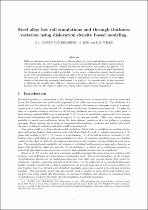 ResearchSpace
ResearchSpace
Steel alloy hot roll simulations and through-thickness variation using dislocation density-based modeling
JavaScript is disabled for your browser. Some features of this site may not work without it.
- ResearchSpace
- →
- Research Publications/Outputs
- →
- Journal Articles
- →
- View Item
| dc.contributor.author |
Jansen van Rensburg, Gerhardus J

|
|
| dc.contributor.author |
Kok, S

|
|
| dc.contributor.author |
Wilke, DN

|
|
| dc.date.accessioned | 2018-10-11T06:58:32Z | |
| dc.date.available | 2018-10-11T06:58:32Z | |
| dc.date.issued | 2017-10 | |
| dc.identifier.citation | Jansen van Rensburg, G.J., Kok, S. and Wilke, D.N. 2017. Steel alloy hot roll simulations and through-thickness variation using dislocation density-based modeling. Metallurgical and Materials Transactions B, vol. 48(5): 2631-2648 | en_US |
| dc.identifier.issn | 1073-5615 | |
| dc.identifier.uri | https://link.springer.com/article/10.1007/s11663-017-1024-7 | |
| dc.identifier.uri | https://doi.org/10.1007/s11663-017-1024-7 | |
| dc.identifier.uri | http://hdl.handle.net/10204/10461 | |
| dc.description | Copyright: 2017 Springer. Due to copyright restrictions, the attached PDF file contains the pre-print version of the published item. For access to the published version, please consult the publisher's website. | en_US |
| dc.description.abstract | Different roll pass reduction schedules have different effects on the through-thickness properties of hot-rolled metal slabs. In order to assess or improve a reduction schedule using the finite element method, a material model is required that captures the relevant deformation mechanisms and physics. The model should also report relevant field quantities to assess variations in material state through the thickness of a simulated rolled metal slab. In this paper, a dislocation density-based material model with recrystallization is presented and calibrated on the material response of a high-strength low-alloy steel. The model has the ability to replicate and predict material response to a fair degree thanks to the physically motivated mechanisms it is built on. An example study is also presented to illustrate the possible effect different reduction schedules could have on the through-thickness material state and the ability to assess these effects based on finite element simulations. | en_US |
| dc.language.iso | en | en_US |
| dc.publisher | Springer | en_US |
| dc.relation.ispartofseries | Worklist;19919 | |
| dc.subject | Steel alloys | en_US |
| dc.subject | Metal slabs | en_US |
| dc.title | Steel alloy hot roll simulations and through-thickness variation using dislocation density-based modeling | en_US |
| dc.type | Article | en_US |
| dc.identifier.apacitation | Jansen van Rensburg, G. J., Kok, S., & Wilke, D. (2017). Steel alloy hot roll simulations and through-thickness variation using dislocation density-based modeling. http://hdl.handle.net/10204/10461 | en_ZA |
| dc.identifier.chicagocitation | Jansen van Rensburg, Gerhardus J, S Kok, and DN Wilke "Steel alloy hot roll simulations and through-thickness variation using dislocation density-based modeling." (2017) http://hdl.handle.net/10204/10461 | en_ZA |
| dc.identifier.vancouvercitation | Jansen van Rensburg GJ, Kok S, Wilke D. Steel alloy hot roll simulations and through-thickness variation using dislocation density-based modeling. 2017; http://hdl.handle.net/10204/10461. | en_ZA |
| dc.identifier.ris | TY - Article AU - Jansen van Rensburg, Gerhardus J AU - Kok, S AU - Wilke, DN AB - Different roll pass reduction schedules have different effects on the through-thickness properties of hot-rolled metal slabs. In order to assess or improve a reduction schedule using the finite element method, a material model is required that captures the relevant deformation mechanisms and physics. The model should also report relevant field quantities to assess variations in material state through the thickness of a simulated rolled metal slab. In this paper, a dislocation density-based material model with recrystallization is presented and calibrated on the material response of a high-strength low-alloy steel. The model has the ability to replicate and predict material response to a fair degree thanks to the physically motivated mechanisms it is built on. An example study is also presented to illustrate the possible effect different reduction schedules could have on the through-thickness material state and the ability to assess these effects based on finite element simulations. DA - 2017-10 DB - ResearchSpace DP - CSIR KW - Steel alloys KW - Metal slabs LK - https://researchspace.csir.co.za PY - 2017 SM - 1073-5615 T1 - Steel alloy hot roll simulations and through-thickness variation using dislocation density-based modeling TI - Steel alloy hot roll simulations and through-thickness variation using dislocation density-based modeling UR - http://hdl.handle.net/10204/10461 ER - | en_ZA |





